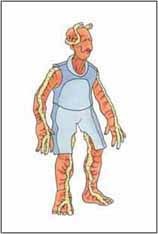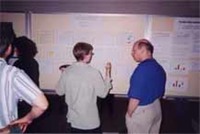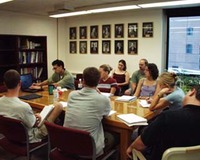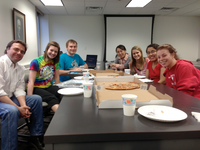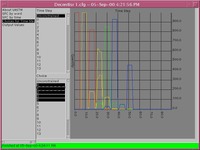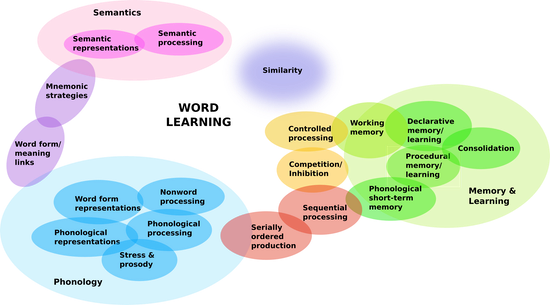
Research in the Language & Memory Lab addresses a variety of issues relating to the schematic shown above. Thus the topics examined in our research include: the role of similarity in the learning of new words, including both similarity at the semantic level and at the phonological level; whether the presence of word meaning affects the learning of phonological word forms, and vice versa; the role of phonological short-term memory in word learning; what the representational differences are, if any, between novel words and known words; the role of sequential processing in word learning; the role of strategic processes in word learning; how any or all of the above may be different in impaired populations; and, at the very broadest level, the nature of similarity, short-term memory, and long-term memory themselves.
An important characteristic of research in our lab is the use of interdisciplinary approaches and multiple methodologies. Thus, we study issues from the perspectives of language processing, memory systems, and cognitive neuroscience, using experimental methods, computational models, and neuropsychological/neuroscientific techniques. It is our belief that the use of converging operations of this kind holds great promise for the elucidation of the issues we are studying.
Some recent and current projects in the lab are described below.
Distinguishing novel word forms from lists of syllables
Nonwords and lists are both novel serial orderings of linguistic units (i.e., phonemes, syllables, or words). Consistent with this, performance in immediate repetition of these stimuli is reliably correlated. Within-nonword serial position effects have also been documented, similar to classic within-list serial position effects, suggesting that nonwords may be akin to lists. But what determines whether a particular sequence of linguistic units is a “list” or a “nonword”? Lists, unlike nonwords, traditionally (i) contain pauses between each item, (ii) have a uniform stress contour, and (iii) have no coarticulation between items. In two experiments, we examined the role of these three variables in distinguishing nonwords from lists, by studying participants’ immediate repetition of sequences of English syllables that incorporated various combinations of the three variables. Stress contour and pauses did not affect repetition performance, but coarticulation had a clear effect, suggesting that coarticulation may be the critical variable distinguishing nonwords from lists.
Does incidental learning suffice for learning of novel word forms?
Four experiments examined phonological word-form learning (i.e., the learning of novel wordlike sound patterns) after differing types of training. In each case, learning at the end of training was assessed via stem-completion ability. Experiment 1 presented subjects with 11 blocks of listening and repeating (incidental learning) and found significant stem-completion ability. The results of Experiment 2 showed greater stem-completion ability after 11 blocks of listening, repeating, and stem-completion testing (deliberate learning). Experiment 3 replicated results from Experiments 1 and 2 in a within-subject design and demonstrated that learning of both types is item-specific and not merely the result of generalized task facilitation. Experiment 4 measured stem-completion ability after 100 blocks of incidental learning and found that it remained lower than after only 11 blocks of deliberate learning in Experiments 2 and 3. These results suggest that incidental learning does not yield full mastery of phonological word forms.
In related work, we have also addressed this question by comparing phonological word form learning in two situations: learning novel word forms as the labels for referents (deliberate word learning); and learning novel word forms through incidental exposure to the word forms alone, without any referents (incidental word form learning, as in the previously discussed study). Phonological word form learning as measured by stem completion ability was found to be better in the former than in the latter situation (Experiment 1). Experiment 2 found that deliberate memorization of word forms, even without any referents, also yielded better stem completion ability than purely incidental learning. These results also suggest that incidental word form learning may not yield full mastery of word forms, and additionally suggest that deliberate learning may be a necessary component for such mastery.
Do newly learned meaningless word forms exhibit competition effects?
Previous work on word learning has highlighted the importance of sleep-based consolidation (Gaskell & Dumay, 2003; 2007) and meaning (Leach & Samuel, 2007) for novel words to start interacting with other words and phonology. In this study, in collaboration with Bob McMurray, we examined word form learning by looking at lexical competition between novel and known words. Following a 15-minute nonword training session, we evaluated whether newly learned words can compete with previously known words during online word recognition. Participants heard word stimuli that were made by cross-splicing novel with known words and the activation of the target word was assessed using the visual world paradigm. We found that meaningless novel word-forms can engage in competition with previously known words with as little as 15 minutes of training. These results indicate that lexical integration is initiated very early in learning and does not require associations with semantic representations or sleep-based consolidation.
Does the similarity of novel word forms to the language affect their processing at a local or global level?
While lexical processing is known to be affected by the similarity of words (or parts of words) to each other or to prior knowledge, most evidence pertains to monosyllabic items. We examined polysyllabic nonwords, manipulating phonotactic probability (PP), a measure of similarity to prior linguistic knowledge. In two experiments, five-syllable nonwords were presented auditorily to participants for immediate repetition. Experiment 1 manipulated PP of the first syllable of each nonword, keeping the remaining syllables identical across conditions, and minimizing relative PP differences across conditions. Experiment 2 manipulated only the second syllable of each nonword, with the same controls as E1. Both experiments revealed syllable-level repetition accuracy effects of PP only at the serial position of the manipulated syllable, and overall repetition accuracy differences between conditions despite their similar overall PP. These results show that participants are sensitive to local similarity in polysyllabic nonword processing even when overall similarity is controlled.
Does similarity among the meanings of words affect the learning of their word forms?
Studies of word learning have focused largely on the learning of various components of words independently (e.g., phonological word forms, or semantics, or the associations between the two), and much less on the relationship between these components during learning. This latter issue, however, bears directly on the question of whether semantics and phonology are separate modules in word learning or whether they interact with each other. This study aimed to shed light on this issue by examining whether one property of semantics, semantic similarity, could influence the learning of phonological word forms. Three behavioral experiments were conducted. Experiment 1 used a naming test to provide evidence about the direction of any effect. Experiments 2 and 3 used a stem completion test and a recognition from mispronunciation test that better controlled for real time processing between conditions so as to enable more valid conclusions about learning. Consistently across these three tests, a detrimental effect of referent similarity was revealed.
Novel word and grammar learning in Specific Language Impairment (SLI)
Our lab's theoretical frameqork emphasizes the contribution of phonological short-term memory (PSTM), procedural learning (PL), and declarative learning (DL) in the acquisition of both words and grammar where all three systems are important to word learning and PSTM and PL are important in grammar learning. In this study, in collaboration with Bruce Tomblin, we asked whether adolescents with SLI differed with respect to the manner in which these systems contributed to their vocabulary and grammatical abilities. A set of novel word learning tasks in conjunction with procedural learning and nonword repetition tasks were administered to age- and performance IQ- matched adolescents with SLI and without SLI. These measures were entered into a confirmatory factor analysis guided by our theory. The best fit model yielded three latent learning/memory traits that were interpreted to be PSTM, PL, and DL. These latent variables were then regressed onto the SLI/TL language status.
Examining and simulating word learning in aphasia
The focus of much investigation in aphasiology has been on assessment of spared vs. impaired performance, with relatively less investigation of spared vs. impaired (re)learning ability. Clearly, however, improved understanding and treatment of aphasia depends on assessment of both. In collaboration with aphasia researchers at Temple University and Moss Rehabilitation Institute in Philadelphia, we have conducted work aimed at employing our theoretical framework for systematic investigation of learning abilities related to word learning. In one study, we examined phonological learning, expressive word learning, and receptive word learning abilities of individuals with aphasia. The aims were, first, to assess these learning abilities, and second, to identify predictors of each, as a step to better understanding of such learning. In addition, we constructed a computational model that accounts for the broad patterns of results.
People
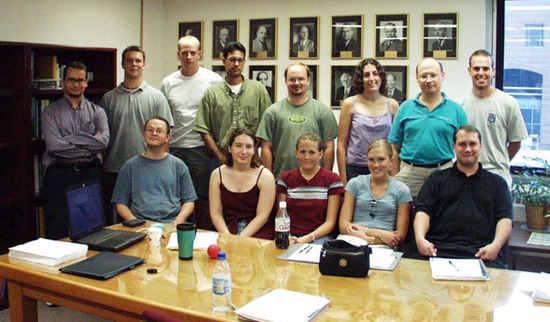
|
Principal Investigator
|
Prahlad Gupta |
|
Graduate Students
|
Francis Smith |
| Libo Zhao | |
|
Collaborators
|
Bruce Tomblin |
| Dan Tranel | |
| Gary Dell | |
| Myrna Schwartz | |
| Bob McMurray | |
| Amanda Van Horne | |
| Jamie Tisdale | |
|
Undergraduate Students
|
Amy Drallmeier |
| Lana Godlewski | |
| Daniel Martin | |
| Allie Schaefbauer | |
|
Graduate Alumni
|
David Ludden |
| Brandon Abbs | |
| Stephanie Packard | |
| Libo Zhao | |
|
Undergraduate Alumni
|
|
| Caitlin Wolf, Melanie Martin, Lauren Suhl, Danielle Tsevas, Laura Crystal, Samantha Cooper, Nicholas Heiserman, Courtney Baittie, Sadie Randall, Abby Topel, Brent Adams, Megan Smith, Jenny DiVita, Hallie Gilmore, Kayla Becraft, Alexandra Mandel, Megan McCurdy, Julie Amendola, Aneta Rysz, Blake Laughton, Becky Herman, Lyndsey Wilson, Scott Intagliata, Dustin Getta, Natasha Bullock-Rest, Ingvild Moen, Alicia Eads, Eric Buss, Tyler Ferguson, David Sabotta, Jessi Hattori, Laura Schwab, Laura Underberg, William Woods, Suzanne Fox, Heather Dumser, Traci Bruns, Nicole Meyer, Ali Ajram, Julia Nash,Brian Armogan, Ryan Smith, Elizabeth Jochem, Claire Thoele, Jessica McCrory, Kim Nguyen, Charles Geilenfeld, Julie Van De Kieft, Amber Foley, Liz Tener, Jon Hintz, Anna Napawan, Byron Murphy, Matthew Woodin, Alyssa Weidenhoff, Melissa Hodapp, Ellen Samuel, Kathleen Schnitker, Sara Even, Milissa Reynolds, Naveen Khetarpal, Linda Wood, James Malicki, Matt Brown, Sierra Spies, Kelly Matlock, Soumya Palreddy, Sarah Oakley, Derek Van Horne, Emily Stiefel, Soo Kim, Dan Kresowik, Ryan Bankson, Lindsay Jones, Po-Han Lin, Rebecca Reese, Jane Wu, Scott Berman, Tony Buhr, Karen langsam, David Stowe, Wendy Troob, Sarah Eisenberg, Warren MacGregor, Jonathan Nauman, Jill Arnold, Emily Anderson, Cindy Herring, Mark Hunter, Staci Keilin, Nathan Miller, Laurel Sallade, Michal Schroeder, Kendra Sieperda, Amber Keppler, Karen Reeder, Tobe Hagge, Stuart Urban |
